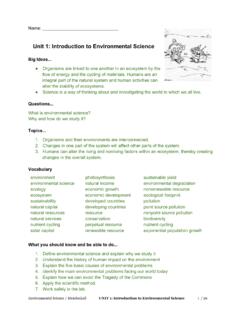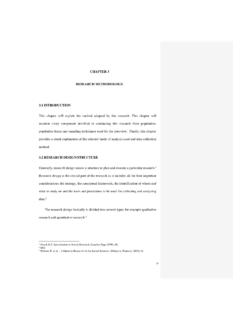Transcription of Chapter 1 Introduction to Principles of Management - ARU
1 Figure make things happenthrough strategic andentrepreneurial leadership. 2010 JupiterimagesCorporationChapter 1 Introduction to Principles of ManagementWHAT S IN IT FOR ME?Reading this Chapter will help you do the who managers are and about the nature of their why you should care about leadership, entrepreneurship, the dimensions of the planning-organizing-leading-controlling (P-O-L-C) how economic performance feeds social and what performance means at the individual and group your survivor s guide to learning and developing Principles re betting that you already have a lot of experience with organizations, teams,and leadership.
2 You ve been through schools, in clubs, participated in social orreligious groups, competed in sports or games, or taken on full- or part-time of your experience was probably pretty positive, but you were also likelywondering sometimes, Isn t there a better way to do this? After participating in this course, we hope that you find the answer to be Yes! While Management is both art and science, with our help you can identify anddevelop the skills essential to better managing your and others behaviors whereorganizations are getting ahead of ourselves, just what is Management , let alone Principles ofmanagement?
3 A manager s primary challenge is to solve problems creatively, andyou should viewmanagement1as the art of getting things done through theefforts of other people. We draw this definition from a biography of Mary ParkerFollett (1868 1933) written by P. Graham,Mary Parker Follett: Prophet of Management (Boston: Harvard Business School Press, 1995). Follett was an American socialworker, consultant, and author of books on democracy, human relations, andmanagement. She worked as a Management and political theorist, introducing suchphrases as conflict resolution, authority and power, and the task ofleadership.
4 Theprinciples of management2, then, are the means by which youactually manage, that is, get things done through others individually, in groups, orin organizations. Formally defined, the Principles of Management are the activitiesthat plan, organize, and control the operations of the basic elements of [people],materials, machines, methods, money and markets, providing direction andcoordination, and giving leadership to human efforts, so as to achieve the soughtobjectives of the enterprise. The fundamental notion of Principles of managementwas developed by French Management theorist Henri Fayol (1841 1925).
5 He iscredited with the original planning-organizing-leading-controlling framework (P-O-L-C), which, while undergoing very important changes in content, remains thedominant Management framework in the world. See H. Fayol,General and IndustrialManagement(Paris: Institute of Electrical and Electronics Engineering, 1916).Forthis reason, Principles of Management are often discussed or learned using aframework called P-O-L-C, which stands for planning, organizing, leading, are required in all the activities of organizations: budgeting, designing,selling, creating, financing, accounting, and artistic presentation; the larger theorganization, the more managers are needed.
6 Everyone employed in anorganization is affected by Management Principles , processes, policies, andpractices as they are either a manager or a subordinate to a manager, and usuallythey are art of getting things donethrough the efforts of means by which youactually manage, that is, getthings done through 1 Introduction to Principles of Management11 Managers do not spend all their time managing. When choreographers are dancinga part, they are not managing, nor are office managers managing when theypersonally check out a customer s credit.
7 Some employees perform only part of thefunctions described as managerial and to that extent, they are mostly managers inlimited areas. For example, those who are assigned the preparation of plans in anadvisory capacity to a manager, to that extent, are making Management decisionsby deciding which of several alternatives to present to the Management . However,they have no participation in the functions of organizing, staffing, and supervisingand no control over the implementation of the plan selected from thoserecommended.
8 Even independent consultants are managers, since they get mostthings done through others thoseothersjust happen to be their clients! Of course,if advisers or consultants have their own staff of subordinates, they become amanager in the fullest sense of the definition. They must develop business plans;hire, train, organize, and motivate their staff members; establish internal policiesthat will facilitate the work and direct it; and represent the group and its work tothose outside of the 1 Introduction to Principles of Management12 Figure Are Managers?
9 LEARNING what is meant by manager . able to describe the types of the nature of managerial tend to think about managers based on their position in an organization. Thistells us a bit about their role and the nature of their responsibilities. The followingfigure summarizes the historic and contemporary views of organizations withrespect to managerial Ghoshal and C. Bartlett,The Individualized Corporation:A Fundamentally New Approach to Management (New York: Collins Business, 1999).Incontrast to the traditional, hierarchical relationship among layers of managementand managers and employees, in the contemporary view, top managers support andserve other managers and employees (through a process called empowerment)
10 , justas the organization ultimately exists to serve its customers and the process of enabling or authorizing an individual to think,behave, take action, and control work and decision making in autonomous both the traditional and contemporary views ofmanagement, however, there remains the need fordifferent types of managersareresponsible for developing the organization s strategyand being a steward for its vision and mission. A secondset of managers includes functional, team, and managersare responsible for theefficiency and effectiveness of an area, such asaccounting or managersare responsible for coordinating a subgroup of aparticular function or a team composed of membersfrom different parts of the organization.







